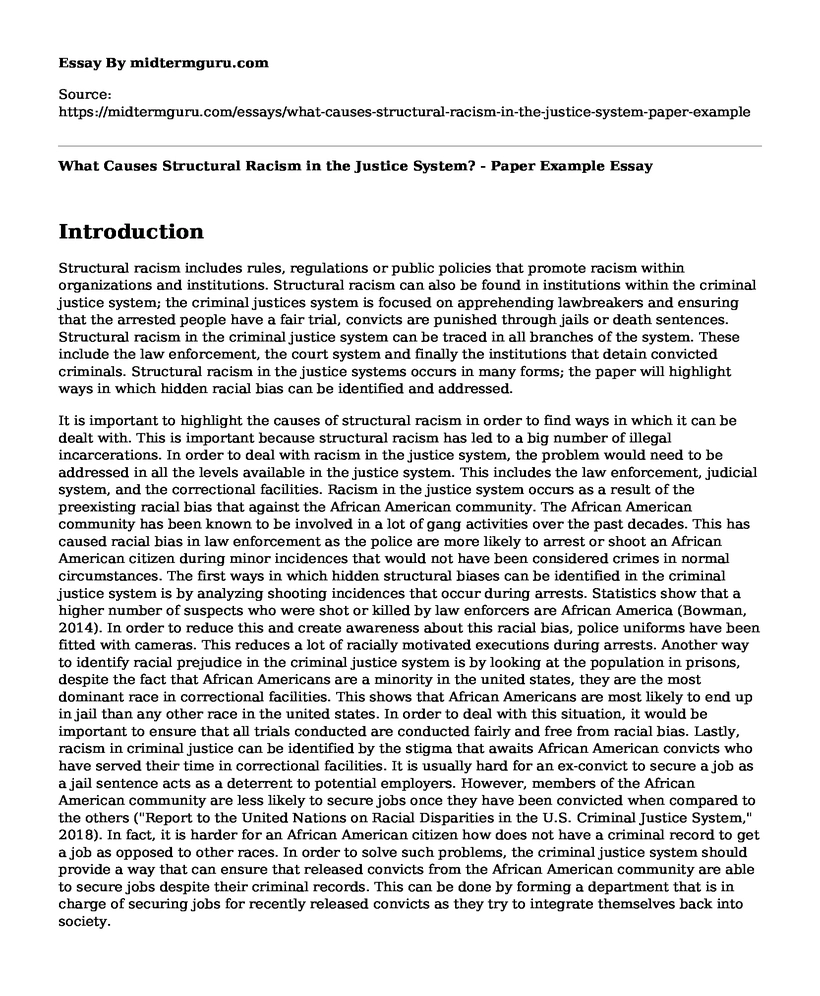Introduction
Structural racism includes rules, regulations or public policies that promote racism within organizations and institutions. Structural racism can also be found in institutions within the criminal justice system; the criminal justices system is focused on apprehending lawbreakers and ensuring that the arrested people have a fair trial, convicts are punished through jails or death sentences. Structural racism in the criminal justice system can be traced in all branches of the system. These include the law enforcement, the court system and finally the institutions that detain convicted criminals. Structural racism in the justice systems occurs in many forms; the paper will highlight ways in which hidden racial bias can be identified and addressed.
It is important to highlight the causes of structural racism in order to find ways in which it can be dealt with. This is important because structural racism has led to a big number of illegal incarcerations. In order to deal with racism in the justice system, the problem would need to be addressed in all the levels available in the justice system. This includes the law enforcement, judicial system, and the correctional facilities. Racism in the justice system occurs as a result of the preexisting racial bias that against the African American community. The African American community has been known to be involved in a lot of gang activities over the past decades. This has caused racial bias in law enforcement as the police are more likely to arrest or shoot an African American citizen during minor incidences that would not have been considered crimes in normal circumstances. The first ways in which hidden structural biases can be identified in the criminal justice system is by analyzing shooting incidences that occur during arrests. Statistics show that a higher number of suspects who were shot or killed by law enforcers are African America (Bowman, 2014). In order to reduce this and create awareness about this racial bias, police uniforms have been fitted with cameras. This reduces a lot of racially motivated executions during arrests. Another way to identify racial prejudice in the criminal justice system is by looking at the population in prisons, despite the fact that African Americans are a minority in the united states, they are the most dominant race in correctional facilities. This shows that African Americans are most likely to end up in jail than any other race in the united states. In order to deal with this situation, it would be important to ensure that all trials conducted are conducted fairly and free from racial bias. Lastly, racism in criminal justice can be identified by the stigma that awaits African American convicts who have served their time in correctional facilities. It is usually hard for an ex-convict to secure a job as a jail sentence acts as a deterrent to potential employers. However, members of the African American community are less likely to secure jobs once they have been convicted when compared to the others ("Report to the United Nations on Racial Disparities in the U.S. Criminal Justice System," 2018). In fact, it is harder for an African American citizen how does not have a criminal record to get a job as opposed to other races. In order to solve such problems, the criminal justice system should provide a way that can ensure that released convicts from the African American community are able to secure jobs despite their criminal records. This can be done by forming a department that is in charge of securing jobs for recently released convicts as they try to integrate themselves back into society.
Conclusion
The racial bias in the criminal justice system might be motivated by the fact that a member of the African American community is more likely to be involved in crimes when compared to their white counterparts. But the system is also seen to have racial tendencies as most law enforcers use the negative African American reputation to make arrests and charge people of crimes they might not have committed. It would be fair if the justice system took steps to ensure that the law enforcers and judges are educated on how to avoid racism at work.
References
Bowman, S. (2014). Color behind bars. Santa Barbara: Praeger, an imprint of ABC-CLIO LLC.
Report to the United Nations on Racial Disparities in the U.S. Criminal Justice System. (2018). Retrieved from https://www.sentencingproject.org/publications/un-report-on-racial-disparities/
Rocque, M. (2011). Racial Disparities in the Criminal Justice System and Perceptions of Legitimacy. Race And Justice, 1(3), 292-315. doi: 10.1177/2153368711409758
Butler, P. (1995). Racially based jury nullification: Black power in the criminal justice system. Yale Lj, 105, 677.
Cite this page
What Causes Structural Racism in the Justice System? - Paper Example. (2022, Sep 11). Retrieved from https://midtermguru.com/essays/what-causes-structural-racism-in-the-justice-system-paper-example
If you are the original author of this essay and no longer wish to have it published on the midtermguru.com website, please click below to request its removal:
- Literary Analysis of The Victims by Sharon Olds - Paper Example
- Essay Sample on Supreme Court Decision about Native Americans
- Research Paper on Healthcare and Poverty
- Should Violence Be Censored From Media For Underage Children? - Essay Sample
- Paper Example on Immigration of the Mexicans to the United States
- Essay Sample on Gang and Drug Abuse
- Research Paper on Fighting Racism in America







